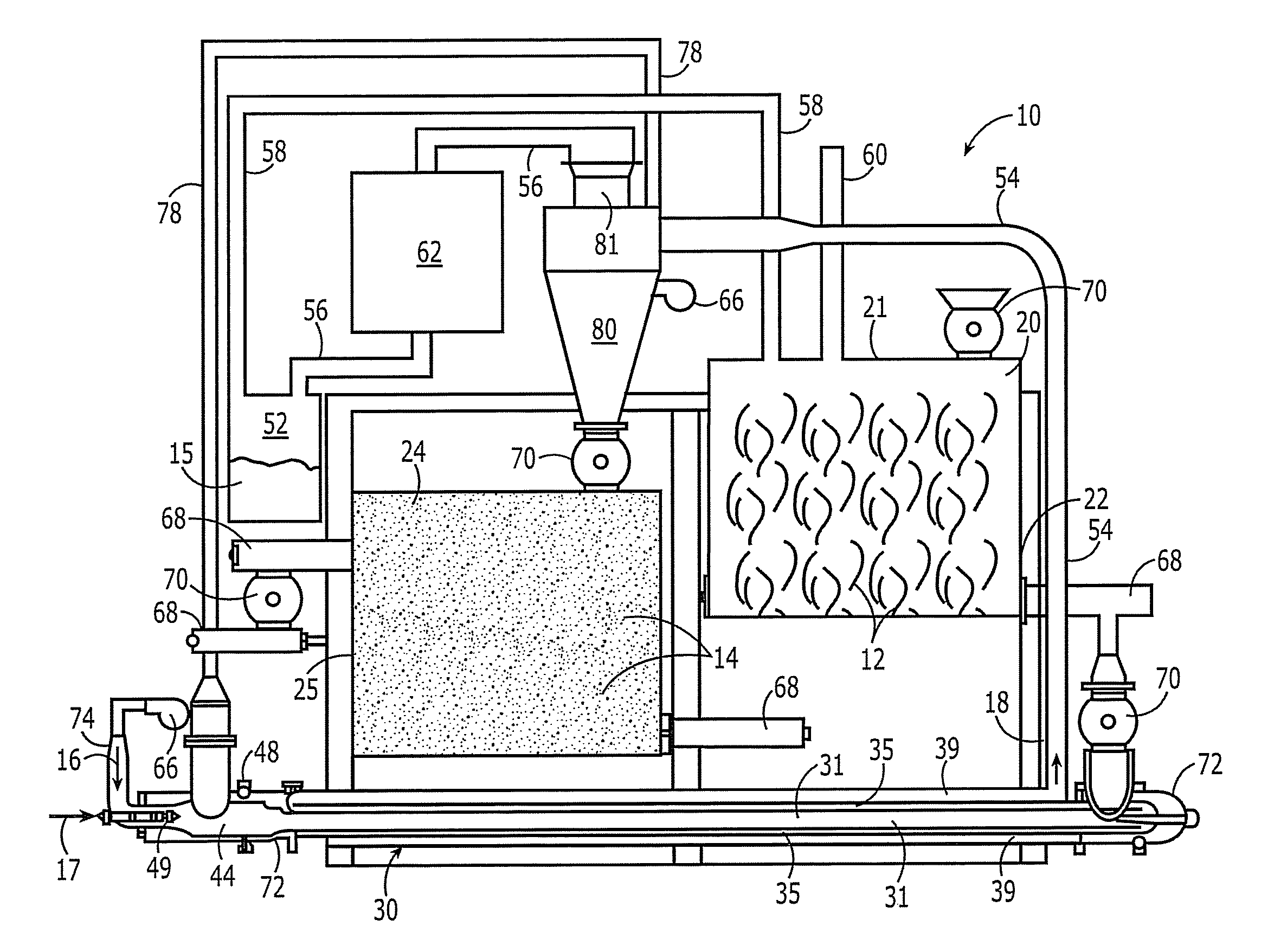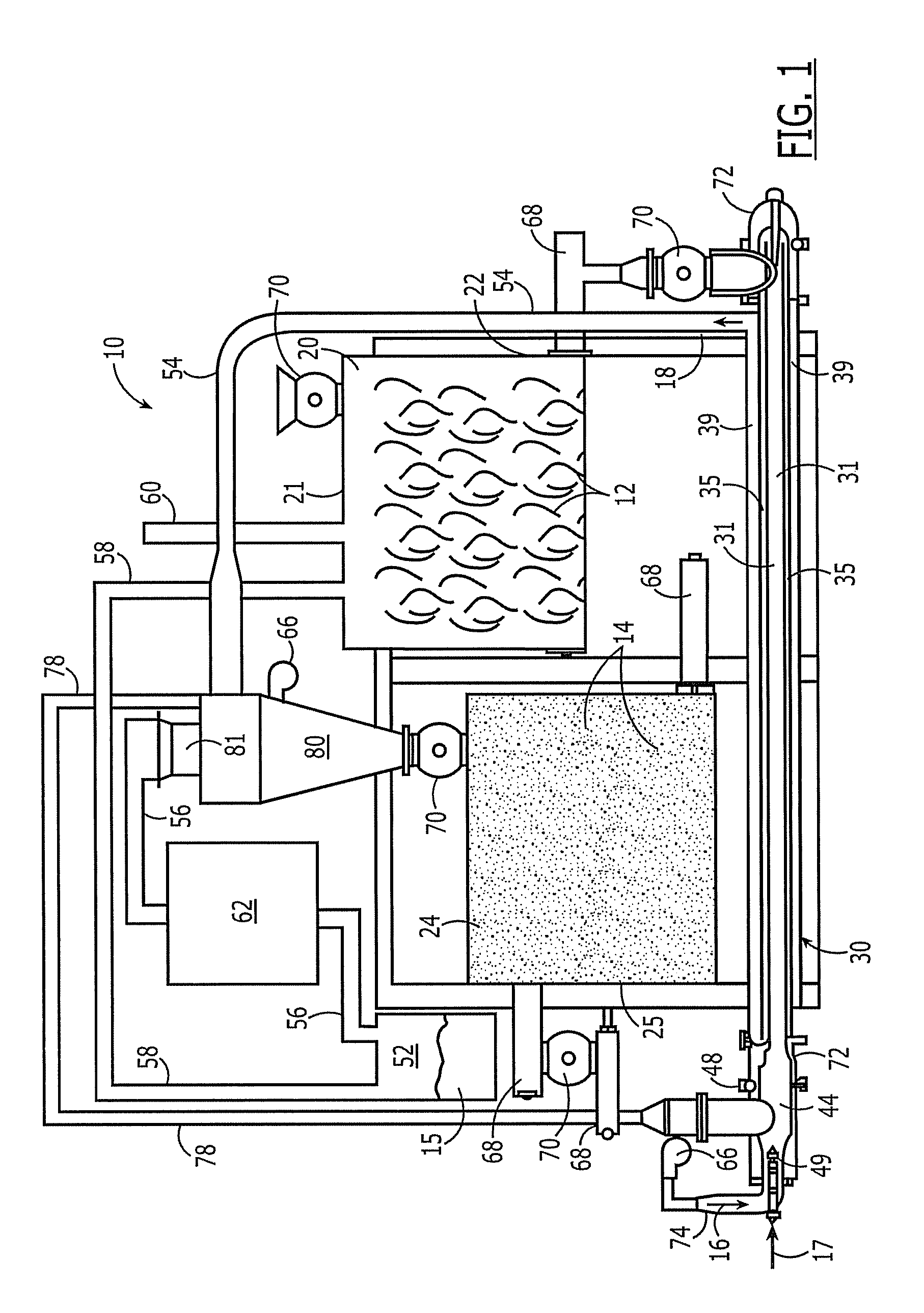Systems, apparatus and methods for optimizing the production of energy products from biomass, such as sawmill waste
a technology of energy products and equipment, applied in the field of systems, apparatus and methods for the production of energy products from carbonizable materials, can solve the problems of nuclear power raising the specter of ecological damage, excessive emission of carbon dioxide into the atmosphere, and substantial environmental problems in the united states, and achieves convenient transportation, efficient pyrolysis, and high efficiency. the effect of speed
- Summary
- Abstract
- Description
- Claims
- Application Information
AI Technical Summary
Benefits of technology
Problems solved by technology
Method used
Image
Examples
first embodiment
[0034]a fast pyrolysis system is depicted in FIGS. 1-4 and designated generally by reference numeral 10.
[0035]Referring now to FIG. 1, the system 10 comprises a biomass feed bin 20 for receiving and delivering biomass 12 that is to be pyrolysized. The biomass feed bin 20 is generally enclosed to provide greater control over the channeling of exhaust 18 (shown as an arrow) from pyrolytic reactions that is fed into the feed bin 20, as described below with reference to FIG. 1. The biomass 12 is fed through a top 21 of the feed bin 20 using a rotary air lock 70. The biomass 12 is delivered from the feed bin 20 by an auger 68 attached to a lower portion 22 of the biomass feed bin 20, as described below with reference to FIGS. 1 and 2. In this way, the biomass feed bin 20 continually cycles new biomass 12 through the system 10.
[0036]Continuing with FIG. 1, the biomass feed bin 20 accepts raw biomass 12. The present embodiment envisions receiving this biomass 12 primarily from sawmills, pa...
second embodiment
[0057]FIG. 5 depicts a concentric-chambered pyrolysis system, designated generally by reference numeral 110, in accordance with the present invention. In the present embodiment, substantially an entire amount of char 14 produced from pyrolytic reactions in a pyrolysis unit 30 is fed back into the system 110 to help fuel further pyrolytic reactions.
[0058]Referring now to FIG. 5, as particles of char 14 exit an open end 88 of a collection cone portion 86 of a cyclone separator 80, the char 14 enters a rotary air lock 70 attached to the open end 88. The rotary air lock 70 feeds the char 14 directly into a char feed duct 123. The char feed duct 123 leads to a char-air input duct 78. The char-air input duct 78, in turn, leads to a burn enclosure 44 of a pyrolysis unit 30. In this way, virtually all of the char 14 produced from pyrolysized biomass 12 is fed back into the system 110 and used to power further fast pyrolytic reactions. Additional fuel 17 (shown as an arrow), such as fuel oil...
embodiment 200
[0068]FIGS. 9 and 10 describe a preferred embodiment of the energy-conversion system 200 shown in FIG. 7. Referring first to FIG. 9, raw biomass 204 is ground into cubes at step 220. The ground biomass 204 is then subjected to drying 230. Optimally, the dried biomass 204 has a moisture content of no more than twelve percent. In other embodiments, steam resulting from the drying process 230 is collected for re-use by other parts of the system 200. Hot exhaust gas 320 from the fast pyrolysis system 206 is used in generating electricity 300 which, in turn, is used to aid in the drying process 230. The exhaust gas 320 has a typical temperature of approximately five-hundred degrees Fahrenheit or greater and has a typical oxygen content of approximately fifteen percent. A portion of the exhaust 320 is also used to aid in fast pyrolysizing the biomass 250. Before the exhaust 320 can be used for fast pyrolysis 250, however, it must be deoxygenated. To rid the exhaust 320 of its oxygen, a fu...
PUM
 Login to View More
Login to View More Abstract
Description
Claims
Application Information
 Login to View More
Login to View More - R&D
- Intellectual Property
- Life Sciences
- Materials
- Tech Scout
- Unparalleled Data Quality
- Higher Quality Content
- 60% Fewer Hallucinations
Browse by: Latest US Patents, China's latest patents, Technical Efficacy Thesaurus, Application Domain, Technology Topic, Popular Technical Reports.
© 2025 PatSnap. All rights reserved.Legal|Privacy policy|Modern Slavery Act Transparency Statement|Sitemap|About US| Contact US: help@patsnap.com



